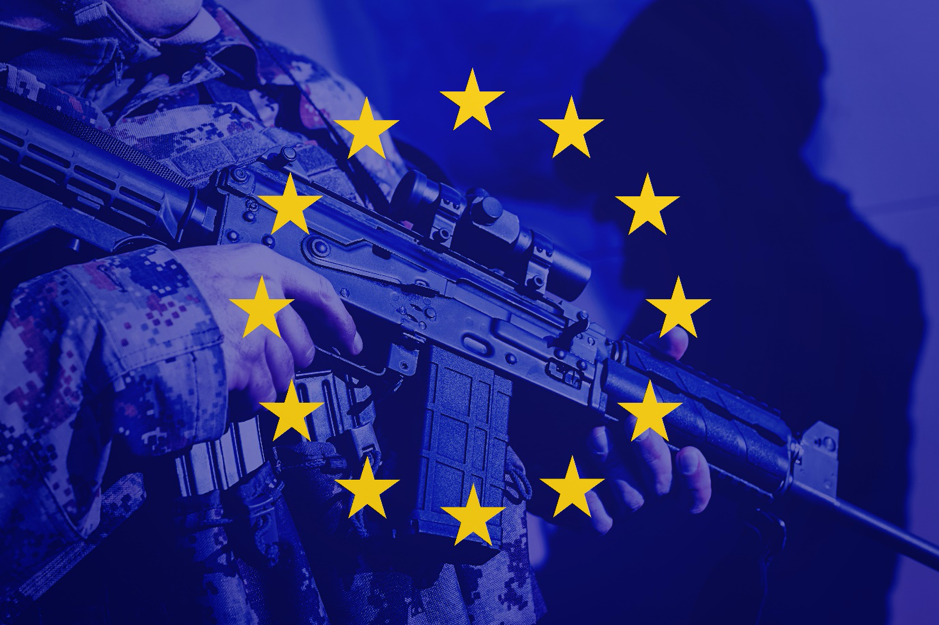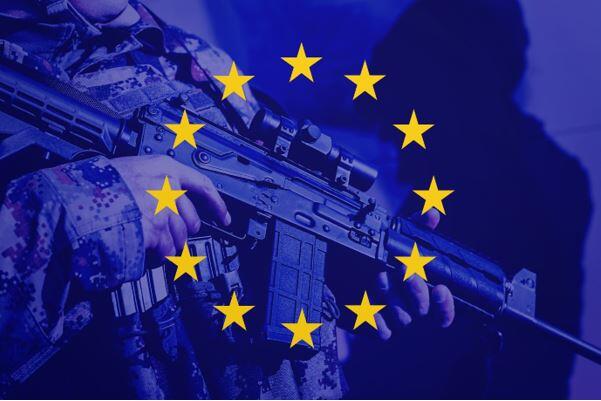Abstract: The idea of a European Army is as old as European integration. A very disputed matter, it has enjoyed both waves of support and vehement opposition, but despite strenuous efforts, it has not become a reality to this day. Efforts have been revived in 2021, and a military doctrine is expected to be ready by 2022.
Bottom-line-up-front: States cherish their foreign policy as one of the main features of statehood, which in turn has slowed down the European Union’s efforts towards the creation of a European Army, alongside the position of a key partner, NATO.
Problem statement: How to understand the reasons the European Union does not yet have an army?
So what?: The European Union should determine whether duplicating functions performed by NATO or having its own army brings more advantages to the table. The Union could consider offering capabilities that would complement those already existing at the NATO level. What is more, the EU should assess whether it is capable of turning the political plan into a reality.

Source: shutterstock.com/Allexxandar
In the Beginning, There Was a Thought…
The story begins with an idea. Promoted by many, the idea of a United Europe gained more and more support with the end of the Second World War. Disappointed by the attempts of others and determined to take matters into their own hands, visionaries such as Alcide de Gasperi, Jean Monnet, Robert Schuman, and Paul-Henri Spaak designed a brilliant plan that became famous as the Schuman Plan. The plan involved the unification of the French and German steel and coal industries which would be under the scrutiny of a Single Authority, leaving the door open for those who also wanted to become members and having the ultimate purpose of preventing future wars.[1] As a result, the European Coal and Steel Community (ECSC) was founded in 1951 by “the inner six,” namely Italy, France and the Benelux countries.[2] Only one year later, the founding Member States signed the Treaty establishing the European Defence Community, which has since remained unratified.[3] The Community would have led to the creation of a pan-European defence force, having as a basis the Pleven Plan, but when it had almost come to fruition, the French National Assembly refused to discuss the matter of ratification, as it would have resulted in the transfer of power in the fields of security and defence to the supranational authority.[4] Whilst the European Coal and Steel Community was already exercising supranational control, the difference in the case of the European Defence Community was that the Members would have had to renounce a power perceived as more vital to their statehood. The French believed that the military integration should not have been realised through the national armies simply joining forces, as this would have resulted once again in “a coalition of old type.”[5] In the words of Dr. David Klemm, in 1950 the European integration witnessed a step towards a European army so remarkable that no one has risen to the same level ever since.[6] Although the Pleven Plan failed, it nonetheless resulted in the birth of the idea of a European army, which was bound to have a bumpy road ahead of it.
Whilst the European Coal and Steel Community was already exercising supranational control, the difference in the case of the European Defence Community was that the Members would have had to renounce a power perceived as more vital to their statehood.
More than a Figleaf?
From that point on, progress has been made in the field of European defence, but the dream of French Prime Minister René Pleven has yet to be achieved. However, the progress has been made with tortoise steps since defence is a competence resting in the hands of the Member States that would not renounce a key competence of statehood under any circumstance. At the EU level, a Common Foreign and Security Policy (CFSP), operating in accordance with the United Nations Charter, currently covers the spheres of security and defence diplomacy.[7] The CFSP Budget is administered by the Commission to promptly provide help in external conflicts, to support EU partners, and to ensure the protection of the EU itself.[8] This is why the CFSP Budget plays a significant role in financing civilian missions, the EU Special Representatives, or disarmament and non-proliferation projects.[9] The civilian missions are conducted with the main goals of making the police and judicial authorities stronger, keeping an eye on the adherence to the international treaties, or providing support for third countries in tackling smuggling, terrorism, and organised crimes.[10] The Special Representatives are independent natural persons who advance certain policies in troubled areas, playing a significant role in the achievement of peace and stability.[11] Whilst the disarmament projects focus on the trafficking of small arms and light weapons, the non-proliferation projects cover international treaties on the proliferation of mass destruction weapons and conventional arms.[12]
One of the main components of the CFSP is the Common Security and Defence Policy (CSDP), which safeguards peace and international security through the implementation of military and civilian missions.[13] Within the CSDP, 25 Member States engage in a Permanent Structured Cooperation (PESCO) to achieve the structural integration of their armed forces.[14] Although the EU has a structure of command and control deployed as part of the CSDP for non-executive operations, it lacks a standing military structure for executive operations.[15] The framework of the CSDP is laid down in the Lisbon Treaty, which increases the power of the Parliament over the policy.[16] Entered into force in 2009, the Lisbon Treaty has amended the Treaty on European Union and the Treaty establishing the European Community.[17] With the introduction of the Lisbon Treaty, support has also appeared for a European Defence Union, which would take integration in the field to the next level. The European Parliament itself militates for the Lisbon Treaty to be used at its full potential in order to achieve this goal.[18] EU leaders, such as Emmanuel Macron[19] and Angela Merkel,[20] have promoted the idea of a European army on multiple occasions. Alongside their leaders, a 2017 Eurobarometer shows that 75% of the EU citizens are supporters of a common policy in the field of security and defence, whilst 55% are in favour of a European Army.[21] Moreover, the Commission of Ursula von der Leyen, the current EU Commission President, has established setting a defence force in motion among its top priorities.[22]
With the introduction of the Lisbon Treaty, support has also appeared for a European Defence Union, which would take integration in the field to the next level.
The proposal of a European army is not without its opponents, however. A constant opponent has been NATO, one of the EU’s closest partners when it comes to defence. During the Cold War, it was the deterrence provided by NATO that helped the Western European states survive the Soviet threat.[23] The EU has subsequently tried to create its own defence force through the Western Union, followed by the Western European Union, or through the European Defence Cooperation, but none of the projects enjoyed the same success as NATO, which shortly after the end of the war was joined by more and more states, helping NATO expand to Eastern Europe.[24] Europe has relied on the help and protection provided by NATO ever since World War II. As 21 out of 27 EU Member States are also part of NATO,[25] some of them fear that a European Army would only compete with NATO. Even the Alliance’s Secretary General Jens Stoltenberg has urged the EU to steer clear of duplicating the functions of NATO.[26] The request is indeed well-founded: why invest in duplicating a function instead of investing in improving the existing ones or in additional ones? The debate has been fuelled on one hand by Gaullists, supporting a self-reliant European Defence, and Atlanticists, on the other hand, wishing to preserve the “status quo,” with NATO as the security provider of the EU.[27]
The request is indeed well-founded: why invest in duplicating a function instead of investing in improving the existing ones or in additional ones?
The past few years have witnessed American Presidents in support of this position, agreeing that duplicating the functions provided by NATO would represent a major error as they encouraged the European States to increase their NATO spending and defence budget to 2% of their GDP[28], making it harder for some of the EU Members to financially support the creation of a European Army. In contrast to his predecessors, President Donald Trump has urged the EU in more instances to strengthen its own defence force despite his own simultaneous recommendation for increased European financial commitment to NATO.[29]
Fiction or Reality?
Controversy over duplicating NATO functions notwithstanding, efforts continue to make a European Army a reality. This year has marked a new attempt towards a the creation of such an army. 14 Member States, namely Austria, Belgium, Cyprus, the Czech Republic, Germany, Greece, France, Ireland, Italy, Luxembourg, the Netherlands, Portugal, Slovenia, and Spain, discussed the possibility of establishing a brigade of 5000 soldiers that would help foreign states in need of urgent support.[30] Less than two decades ago, the EU Battlegroups were created but have since remained inactive.[31] Talks are being held about turning the battlegroups into a credible Initial Entry Force.[32] Preparations in this direction began in 2020 when the EU assessed its military shortcomings.[33] This year, an armament budget has been agreed upon, and a military doctrine should be ready by 2022.[34] With the UK’s withdrawal, a military power has left the EU, but this has also enabled the Union to work towards deeper defence cooperation and increase its role in the field. With France in the lead, the EU considers drawing a “Strategic Compass”, as it wishes to become an independent military power in the future, that has been compared with NATO’s “Strategic Concept” and will present the goals of the alliance.[35] Although the EU seems to be slowly heading towards establishing an EU army, Reuters’ sources from Brussels said the matter “is not under discussion,”[36] which leads to the conclusion that the European army will remain a mere fiction at the moment.
With the UK’s withdrawal, a military power has left the EU, but this has also enabled the Union to work towards deeper defence cooperation and increase its role in the field.
Valentina Ioana Alexandru, L.L.B. candidate in International and European Law at The Hague University of Applied Sciences. The views contained in this article are the author’s alone and do not represent the views of The Hague University of Applied Sciences.
[1] “The Schuman Declaration – 9 May 1950,” European Union, accessed July 10, 2021, https://europa.eu/european-union/about-eu/symbols/europe-day/schuman-declaration_en .
[2] “Our history,” European Defence Agency, accessed July 12, 2021, https://eda.europa.eu/our-history/our-history.html.
[3] European Defence Agency, “Our history.”
[4] European Defence Agency, “Our history.”
[5] Ben T. Moore, NATO and the Future of Europe (New York: Council on Foreign Relations by Harper & Brothers).
[6] David Klemm, “An Attempt to Establish the European Army: The Pleven Plan,” Journal on
European History of Law 7, no. 1 (2016): 105-109.
[7] “Common foreign and security policy,” European Commission, accessed July 12, 2021, https://ec.europa.eu/fpi/what-we-do/common-foreign-and-security-policy_ro.
[8] European Commission, “Common foreign and security policy.”
[9] European Commission, “Common foreign and security policy.”
[10] European Commission, “Common foreign and security policy.”
[11] European Commission, “Common foreign and security policy.”
[12] European Commission, “Common foreign and security policy.”
[13] “Common security and defence policy,” European Parliament, accessed July 12, 2021, https://www.europarl.europa.eu/factsheets/en/sheet/159/common-security-and-defence-policy.
[14] “About PESCO,” PESCO, accessed July 14, 2021, https://pesco.europa.eu/.
[15] European External Action Service, “EUROPEAN UNION CONCEPT FOR MILITARY COMMAND AND CONTROL,” (EEAS Working Document, EEAS, 2019), https://data.consilium.europa.eu/doc/document/ST-8798-2019-INIT/en/pdf.
[16] European Parliament, “Common security and defence policy.”
[17] “The Treaty of Lisbon,” European Parliament, accessed July 10, 2021, https://www.europarl.europa.eu/factsheets/en/sheet/5/the-treaty-of-lisbon.
[18] Étienne Bassot, “Unlocking the potential of the EU Treaties,” (EPRS Study, EPRS, 2019), https://www.europarl.europa.eu/RegData/etudes/STUD/2019/630353/EPRS_STU(2019)630353_EN.pdf.
[19] “Initiative pour l’Europe – Discours d’Emmanuel Macron pour une Europe souveraine, unie, démocratique,” ÉLYSÉE, September 26, 2017, https://www.elysee.fr/emmanuel-macron/2017/09/26/initiative-pour-l-europe-discours-d-emmanuel-macron-pour-une-europe-souveraine-unie-democratique.
[20] “Merkel: Nationalism and egoism must never have a chance again in Europe,” European Parliament, accessed July 14, 2021, https://www.europarl.europa.eu/news/en/press-room/20181106IPR18316/merkel-nationalism-and-egoism-must-never-have-a-chance-again-in-europe.
[21] “Defence: is the EU creating a European army?,” European Parliament, accessed July 14, 2021, https://www.europarl.europa.eu/news/en/headlines/security/20190612STO54310/eu-army-myth-what-is-europe-really-doing-to-boost-defence.
[22] Étienne Bassot, “The von der Leyen Commission’s six priorities: State of play in autumn 2020,” (EPRS Briefing, EPRS,2020), https://www.europarl.europa.eu/RegData/etudes/BRIE/2020/652053/EPRS_BRI(2020)652053_EN.pdf.
[23] “European Defence Agency, “Our history.”
[24] European Defence Agency, “Our history.”
[25] “Relations with the European Union,” NATO, accessed August 11, 2021, https://www.nato.int/cps/en/natohq/topics_49217.htm.
[26] “Joint press point,” NATO, accessed August 11, 2021, https://www.nato.int/cps/on/natohq/opinions_118046.htm.
[27] “AN EU ARMY? FOUR REASONS IT WILL NOT HAPPEN,” Centre for European Reform, accessed August 11, 2021, https://www.cer.eu/insights/eu-army-four-reasons-it-will-not-happen.
[28] Jeffrey Goldberg, “The Obama Doctrine,” The Atlantic, August 11, 2021, https://www.theatlantic.com/magazine/archive/2016/04/the-obama-doctrine/471525/
[29] David M. Herszenhorn, “Biden urged to push EU to be a military power,” Politico, July 14, 2021, https://www.politico.eu/article/report-joe-biden-should-push-eu-to-become-a-global-military-power-nato-defense/.
[30] Robin Emmott, “EU seeks rapid response military force, two decades after first try,” Reuters, July 14, 2021, https://www.reuters.com/world/europe/eu-seeks-rapid-response-military-force-two-decades-after-first-try-2021-05-05/
[31] “EU Battlegroups,” European External Action Service, accessed August 11, 2021, https://eeas.europa.eu/headquarters/headquarters-Homepage/33557/eu-battlegroups_en.
[32] Robin Emmott, “Strategic Compass: EU considers military doctrine, new tank development,” Reuters, July 14, 2021, https://www.reuters.com/article/us-eu-defence-idUSKBN27Z1JQ.
[33] Emmott, “EU seeks rapid response military force, two decades after first try.”
[34] Emmott, “EU seeks rapid response military force, two decades after first try.”
[35] Emmott, “Strategic Compass: EU considers military doctrine, new tank development.”
[36] Emmott, “Strategic Compass: EU considers military doctrine, new tank development.”





